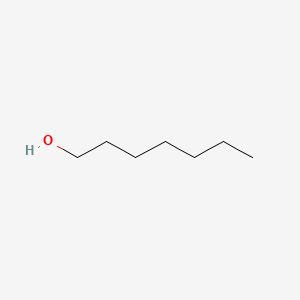| MeSH term | MeSH ID | Detail |
|---|---|---|
| Eye Burns | D005126 | 13 associated lipids |
| Ventricular Dysfunction, Left | D018487 | 33 associated lipids |
| Tachycardia, Ventricular | D017180 | 9 associated lipids |
| Heart Injuries | D006335 | 6 associated lipids |
| Wounds, Gunshot | D014948 | 2 associated lipids |
| Tachycardia, Ectopic Atrial | D013612 | 1 associated lipids |
n-heptanol
N-heptanol is a lipid of Fatty Acyls (FA) class. N-heptanol is associated with abnormalities such as Corneal Neovascularization. N-heptanol often locates in Epithelium and Structure of corneal epithelium. The related lipids are Heptanol.
Cross Reference
Introduction
To understand associated biological information of n-heptanol, we collected biological information of abnormalities, associated pathways, cellular/molecular locations, biological functions, related genes/proteins, lipids and common seen animal/experimental models with organized paragraphs from literatures.
What diseases are associated with n-heptanol?
n-heptanol is suspected in Corneal Neovascularization and other diseases in descending order of the highest number of associated sentences.
Related references are mostly published in these journals:
| Disease | Cross reference | Weighted score | Related literature |
|---|
Possible diseases from mapped MeSH terms on references
We collected disease MeSH terms mapped to the references associated with n-heptanol
PubChem Associated disorders and diseases
What pathways are associated with n-heptanol
There are no associated biomedical information in the current reference collection.
PubChem Biomolecular Interactions and Pathways
Link to PubChem Biomolecular Interactions and PathwaysWhat cellular locations are associated with n-heptanol?
Visualization in cellular structure
Associated locations are in red color. Not associated locations are in black.
Related references are published most in these journals:
| Location | Cross reference | Weighted score | Related literatures |
|---|
What functions are associated with n-heptanol?
There are no associated biomedical information in the current reference collection.
What lipids are associated with n-heptanol?
Related references are published most in these journals:
| Lipid concept | Cross reference | Weighted score | Related literatures |
|---|
What genes are associated with n-heptanol?
There are no associated biomedical information in the current reference collection.
What common seen animal models are associated with n-heptanol?
There are no associated biomedical information in the current reference collection.
NCBI Entrez Crosslinks
All references with n-heptanol
Download all related citations| Authors | Title | Published | Journal | PubMed Link |
|---|---|---|---|---|
| Bernardini G et al. | Lethality, teratogenicity and growth inhibition of heptanol in Xenopus assayed by a modified frog embryo teratogenesis assay-Xenopus (FETAX) procedure. | 1994 | Sci. Total Environ. | pmid:8079149 |
| Ma J et al. | Ryanodine receptor of skeletal muscle is a gap junction-type channel. | 1988 | Science | pmid:2459777 |
| Phanichphant S et al. | Flame-made Nb-doped TiO2 ethanol and acetone sensors. | 2011 | Sensors (Basel) | pmid:22346586 |
| Campagnoli A et al. | Use of the electronic nose as a screening tool for the recognition of durum wheat naturally contaminated by deoxynivalenol: a preliminary approach. | 2011 | Sensors (Basel) | pmid:22163882 |
| Malvindi MA et al. | Rod-shaped nanocrystals elicit neuronal activity in vivo. | 2008 | Small | pmid:18844306 |
| Jiang YB and Jin MG | Intramolecular charge transfer at reverse micelle-water pool interface: p-N,N-dimethylaminobenzoic acid in AOT/cyclohexane/water reverse micelle. | 2000 | Spectrochim Acta A Mol Biomol Spectrosc | pmid:10794439 |
| Smith AS et al. | Microphysiological systems and low-cost microfluidic platform with analytics. | 2013 | Stem Cell Res Ther | pmid:24565109 |
| Sugii A et al. | Extraction chromatography with macroreticular polymer beads impregnated with monothiodibenzoylmethane solution. | 1982 | Talanta | pmid:18963217 |
| Jitsanong T et al. | Diarylheptanoid 7-(3,4 dihydroxyphenyl)-5-hydroxy-1-phenyl-(1E)-1-heptene from Curcuma comosa Roxb. protects retinal pigment epithelial cells against oxidative stress-induced cell death. | 2011 | Toxicol In Vitro | pmid:21044678 |
| Tsai ML et al. | Acute inhibition of spontaneous uterine contractions by an estrogenic polychlorinated biphenyl is associated with disruption of gap junctional communication. | 1998 | Toxicol. Appl. Pharmacol. | pmid:9772196 |
